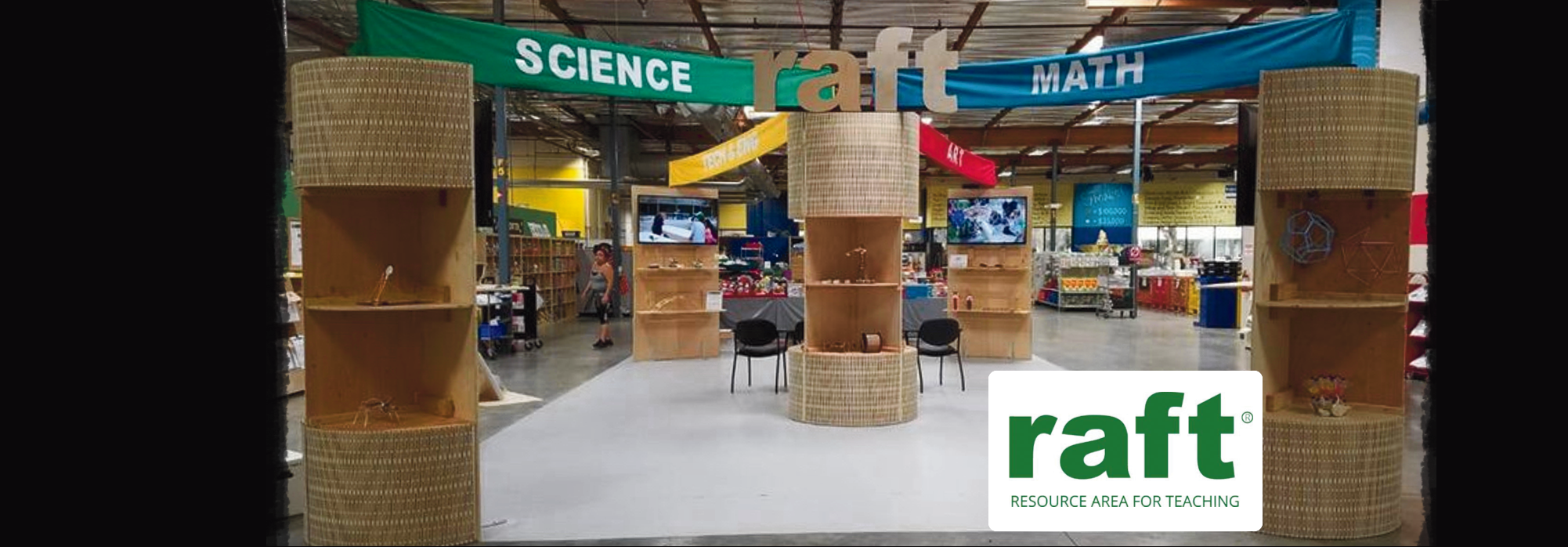Rebooting RAFT
When I stepped into the role of Director of Learning at RAFT, a nonprofit dedicated to providing educators with affordable, sustainable classroom materials, I was tasked with reigniting enthusiasm among both donors and teachers by showcasing the organization’s impact and potential. Leading this effort alongside me was Kipp Lanman—first as my executive coach and later as my mentor and RAFT’s CEO—whose visionary leadership and dedication to innovation played a pivotal role in shaping our direction. Our primary goal was to reaffirm RAFT’s core mission: providing high-quality, low-cost, upcycled materials to educators while simultaneously developing new, innovative products and services to meet the ever-changing needs of today’s learners.
I hope to document the evolution of RAFT and the visionary initiatives that have reshaped its trajectory. From the redesign of products and rejuvenation of the brand to fostering community involvement through immersive events and a renovation of its teacher store, RAFT experienced a significant evolution from 2015-2017. These endeavors expanded the horizons of my educational resourcefulness as well. As a result, my aspiration in writing this article is that educators and communities will discover within these words a source of inspiration to envision the future of learning.
Brand and Product Redesign
One of our first initiatives was to address the financial strain caused by the depletion of large material donations. We observed that when these donations ran out, RAFT resorted to purchasing items to sustain its product offerings, resulting in increased overhead costs and decreased interest from both customers and donors. To tackle this issue, my team and I created the makerspace-in-a-box kit, a flexible product that could be assembled using a variety of donated materials. This kit not only reduced expenses but also provided comprehensive lesson plans aligned with educational standards, offering teachers a valuable resource for hands-on learning experiences. Additionally RAFT needed to move its packaging away from plastics, as it packaged most kits in plastic bags. Certain donors were unwilling to sponsor kits unless the packaging was biodegradable, sustainable and responsible.
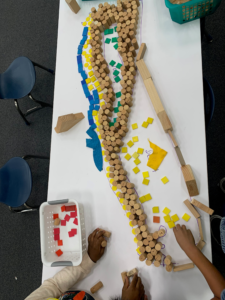
The introduction of the Makerspace-in-a-Box kit marked a pivotal moment for RAFT, not just in terms of product innovation, but also in redefining its brand identity and opening doors to new services.
As the demand for sustainable packaging grew among RAFT’s donors, it became imperative to revamp the packaging materials. Plastic bags, once used for kit packaging, were no longer acceptable to donors concerned about environmental impact. In response, the Makerspace-in-a-Box kit was packaged using recycled cardboard, setting a new standard for sustainability in RAFT’s product offerings.
However, the shift towards sustainability wasn’t limited to packaging alone. It catalyzed a broader rebranding effort, encompassing a logo redesign, website overhaul, and new product packaging. The original RAFT logo, harkening back to its math tessellations kit, no longer aligned with the organization’s evolving focus. It was intricate and overloaded with information, failing to convey a cohesive brand message. Worst of all, it became apparent that the design was being misinterpreted by customers, with some expressing concerns that it bore an unintended resemblance to controversial symbols. The new logo needed to be streamlined, modern, and instantly recognizable.
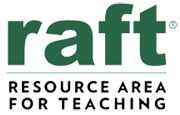
Simultaneously, the website needed a transformation to enhance the online shopping experience and showcase RAFT’s expanded services. With a background in design and recognizing the need for a more modern and welcoming brand image, I took the initiative to redesign the website enhancing the user experience and ensuring the new branding was seamlessly integrated across all platforms. To support RAFT’s commitment to sustainability and adaptability, I also spearheaded the creation of raft.education, an online resource hub offering lesson plans that utilized RAFT’s upcycled materials. This new platform reduced reliance on specific material kits, allowing educators to access adaptable project ideas that aligned with STEAM standards and were sustainable in the long term. I trained RAFT’s education team to use a content management system resulting in a seamless pipeline of new content on our website from RAFT’s lesson design team.
Through these strategic changes, RAFT not only addressed donor concerns about sustainability but also redefined its visual identity and online presence. The makerspace in a box kit served as a catalyst for broader organizational evolution, signaling RAFT’s commitment to innovation and sustainability in education.
The Makerspace-in-a-Box’s alignment with educational standards and wide variety of comprehensive K-8 lesson plans made it an ideal choice for schools looking to incorporate hands-on learning experiences into their curriculum. Its modular design and adaptable nature allowed educators to tailor makerspace activities to meet the specific needs and interests of their students, fostering creativity, critical thinking, and collaboration.
Later when we began serving schools with direct resupply through our in school makerspace program, integrating the Makerspace-in-a-Box into school makerspace builds, we not only expanded its reach but also maximized its impact. Schools across the region embraced this innovative approach, transforming traditional learning spaces into hubs of innovation and exploration. The Campbell Union School District purchased a kit for every classroom teacher it employed. The Makerspace-in-a-Box became more than just a product; it became a catalyst for change, empowering educators to reimagine the possibilities of hands-on learning.
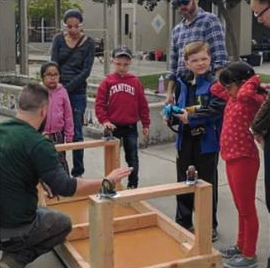
Makerspace Build Days for Families and School Communities
Building on that possibility, we launched immersive school events aimed at engaging parents, teachers, students, and staff in the construction of outdoor classrooms. These events fostered strong bonds between RAFT and school communities, demonstrating our commitment to collaborative learning experiences.
My experience as a teacher with school-wide garden building events played a pivotal role in shaping these initiatives. Drawing from the Saturday garden building events that I helped lead in DC area schools, I understood the transformative power of community engagement. These events not only brought together students, teachers, and parents but also instilled a sense of ownership and pride in the school environment. It was this spirit of collaboration and hands-on learning that we sought to replicate in our outdoor classroom events.
To share our vision and recuit stakeholders, we first created prototype spaces to showcase the potential of mobile in-school makerspaces. Partnering with Synapse School, we embarked on a transformative journey to design and build a state-of-the-art makerspace that would serve as a model for future educational environments. With a generous recommendation from Larry Page, cofounder of Google, to Synapse’s principal, we began to discuss vision and philosophy of learning and found that we had exciting overlap. Within one month, we transformed a vision into reality, creating a dynamic hub of creativity and innovation for the Synapse community that grew to become a central part of the Synapse school curriculum.
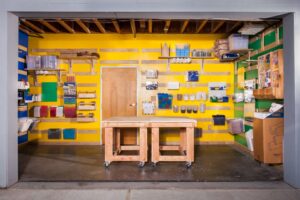
The Synapse makerspace project was a collaborative effort, not just between RAFT and Synapse, but also drawing upon the expertise of Project Ember, a trusted partner with a proven track record in designing hands-on learning experiences. Project Ember’s cofounder Joshua Rothhaas helped me prototype and demonstrate the first major project of the Khan Lab School, a full sized go kart race track on Google’s campus built by students. I knew Josh shared this vision and would be a great fit with the Synapse philosophy. Together, we created a space that not only inspired students but also provided teachers with valuable insights into best practices and strategies in hands-on education.
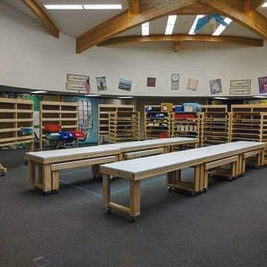
Kipp Lanman, RAFT’s CEO and a former intel executive, played a pivotal role in expanding the makerspace program, leveraging his expertise and network to garner support from key stakeholders. His strategic guidance and unwavering commitment were instrumental in securing funding and resources to scale up the program, enabling RAFT to reach hundreds of schools across the region.
Kipp’s next challenge was to help the program grow ten times larger. After creating the first six in school makerspaces and organizing those in school events, RAFT could demonstrate both the value to school communities and had excited donors with a new opportunity to support schools directly. RAFT had existing relationships with several school districts as well as several county offices in the region, so I began reaching out to explore the interests and needs of those partners to find potential good fits for our program. Public school entities were very excited by the low cost and high engagement offered to students and well as the year round support, training and material resupply that was included at one flat cost with our service.
Within a few months we bagen planning a year of builds and support for the majority of schools in the Berressa and Ravenswood school districts as well as the entire Orchard and Campbell Union School District. Within a year we were training the leadership at the Sacramento County Office of Education to run the entire program themselves offering our suppliers and contractors direct relationships with Sacramento in order to see the philosophy within the project expand without limitation throughout the region.
Remodeling the Store
The hand-built remodel of RAFT’s flagship store in San Jose stands as a testament to the power of vision, collaboration, and craftsmanship. Spearheaded by Kipp Lanman and myself, this ambitious project aimed to redefine the shopping experience for educators while showcasing RAFT’s commitment to innovation and excellence.
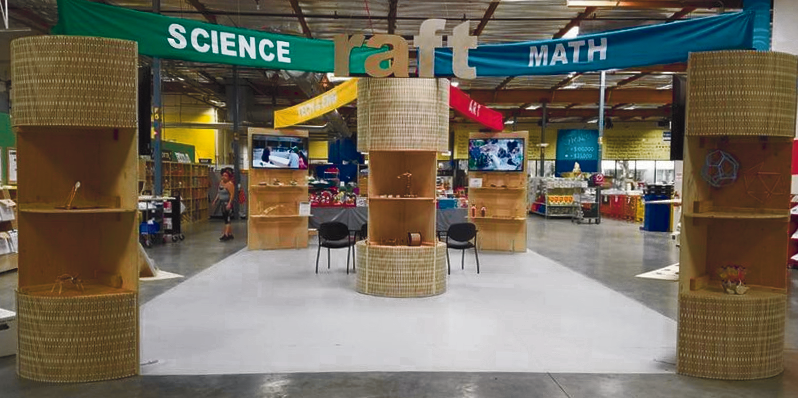
Kipp’s expertise as both a leader and a skilled woodworker played a pivotal role in bringing our vision to life. Together, we embarked on a journey to reimagine every aspect of the store, from layout and design to functionality and aesthetics. Our goal was to create an immersive environment that would inspire and empower educators while showcasing RAFT’s extensive range of products and services.
To optimize the shopping experience, we analyzed and addressed pain points in the retail environment, leveraging modern technologies and innovative design solutions. Small-scale prototypes and mock-ups allowed us to fine-tune our ideas and gain consensus throught the company before implementing them on a larger scale. We incorporated large round shelving units with laser-cut “living hinge” patterns, providing ample space for product display and organization. Strategic placement of banners and signage guided customers to subject-specific products, ensuring a seamless shopping experience tailored to educators’ needs.
The highlight of the remodel was the creation of massive eight and ten-foot structures that transformed the store into a captivating and dynamic space. Crafted with care and attention to detail, these structures evoked a sense of grandeur and excitement, setting the stage for an unforgettable shopping experience. Video screens came to life with product demos and student learning experiences, adding a multimedia dimension to the store’s ambiance.
As customers entered the remodeled store, they were greeted by an atmosphere reminiscent of a grand circus tent, teeming with energy and possibility. The remodel not only revitalized the physical space but also reinvigorated RAFT’s mission to empower educators and inspire learning. It was a testament to the transformative power of collaboration, creativity, and dedication to excellence.
An Inspiring Legacy
I can not write about the work at RAFT without writing about Kip Lanman and the work he did to inspire and make it all possible. Despite Kipp’s untimely passing, his legacy continues to inspire us to push the boundaries of innovation and collaboration. As we look to the future, we remain dedicated to realizing Kipp’s vision of transforming education and making a lasting impact on the lives of teachers and students.
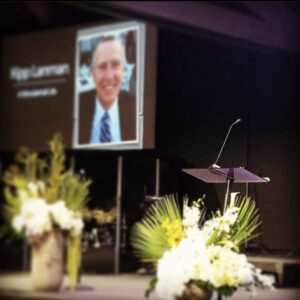 Reflecting on the remarkable transformation of RAFT and its profound impact on education, I am deeply grateful for the invaluable mentorship and friendship of Kipp Lanman. Kipp’s visionary leadership and unwavering commitment propelled RAFT to new heights, leaving his mark on the landscape of educational innovation.
Reflecting on the remarkable transformation of RAFT and its profound impact on education, I am deeply grateful for the invaluable mentorship and friendship of Kipp Lanman. Kipp’s visionary leadership and unwavering commitment propelled RAFT to new heights, leaving his mark on the landscape of educational innovation.
At the core of our collaboration was Kipp’s steadfast belief in the potential of hands on experiences to open doors to passion for learning. Our commitment to using up-cycled materials to revolutionize learning environments and alleviate educational costs, gave me a deep sense of pride and satisfaction in our work. Together, we not only developed groundbreaking products and services but also cultivated a sense of community and empowerment among educators and students alike.
Looking ahead, Kipp’s legacy serves as a beacon of inspiration for educators, donors, and community members. By embracing the principles of sustainability, creativity, and collaboration, we unlock endless possibilities for enriching learning experiences and strengthening the bonds between schools and their communities.
I hope to continue to honor Kipp’s enduring legacy by continuing to push the boundaries of innovation and excellence in education. Together, we can forge a path towards a brighter future where every learner has the opportunity to thrive and succeed.

